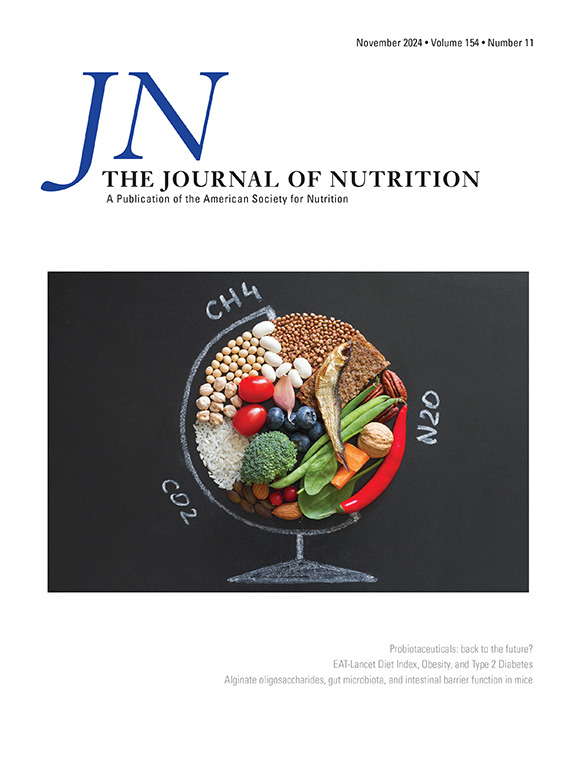Association of Low-Calorie Sweeteners with Selected Circulating Biomarkers of Intestinal Permeability in the Cancer Prevention Study-3 Diet Assessment Substudy
IF 3.7
3区 医学
Q2 NUTRITION & DIETETICS
引用次数: 0
Abstract
Background
Low-calorie sweeteners (LCSs) are popular sugar substitutes and have been shown to alter the gut microbiota, which raises concerns about potential impacts on intestinal permeability.
Objectives
This study aimed to examine cross-sectional associations between LCS consumption and circulating biomarkers of intestinal permeability.
Methods
We analyzed data from 572 United States adults participating in the Cancer Prevention Study-3 Diet Assessment Substudy who provided ≤2 fasting blood samples, collected 6 mo apart, to measure biomarkers of intestinal permeability including antibodies to flagellin (anti-flagellin), lipopolysaccharide (anti-LPS), and total antibodies; and ≤6 24-h dietary recalls, collected over the course of 12 mo, to estimate average intake of LCS including aspartame, sucralose, acesulfame-potassium, and saccharin. Multivariable linear regression, adjusted for sociodemographic characteristics, lifestyle factors, and medical history, was used to examine associations between LCS consumption and levels of intestinal permeability biomarkers by comparing mean differences in biomarkers among lower (>0 to ≤50th percentile) (n = 158) and higher (>50th percentile) LCS consumers (n = 157) than nonconsumers. A linear trend across nonconsumers and the 2 consumption categories was evaluated using a continuous variable based on the median LCS intake (median = 0, 11.3, and 124.2 mg/d for non-, lower, and higher consumers, respectively).
Results
Among the 572 study participants, the mean age was 52.5 y, 63.3% were female, 60.7% were on-Hispanic White, and 55.1% reported consuming LCS-containing products. Greater LCS consumption was not associated with anti-flagellin, anti-LPS, or total antibodies. Additionally, no associations between specific types of LCS and intestinal permeability biomarkers were observed.
Conclusions
The results of our study did not demonstrate an association between LCS consumption and intestinal permeability biomarkers. Further research with larger sample sizes and randomized controlled trials is needed to confirm our findings.
在癌症预防研究-3饮食评估亚研究中,低热量甜味剂与选定的肠道通透性循环生物标志物的关联
背景:低热量甜味剂(LCS)是流行的糖替代品,已被证明可以改变肠道微生物群,这引起了对肠道通透性潜在影响的担忧。目的:研究LCS消耗与肠通透性循环生物标志物之间的横断面关联。方法:我们分析了参与癌症预防研究-3饮食评估亚研究的572名美国成年人的数据,他们提供了多达两个空腹血液样本,相隔6个月收集,以测量肠道通透性的生物标志物,包括鞭毛蛋白抗体(抗鞭毛蛋白),脂多糖(抗lps)和总抗体;并在12个月内收集多达6次24小时的饮食召回,以估计LCS的平均摄入量,包括阿斯巴甜、三氯蔗糖、乙酰磺胺钾和糖精。通过比较低(>50百分位)和高(>50百分位)LCS消费者(n=157)与非LCS消费者(n=157)之间生物标志物的平均差异,采用多变量线性回归,调整了社会人口统计学特征、生活方式因素和病史,以检验LCS消费与肠通透性生物标志物水平之间的关系。使用基于中位数LCS摄入量的连续变量来评估非消费者和两种消费类别之间的线性趋势(非、低和高消费者的中位数分别为0,11.3和124.2 mg/天)。结果:在572名研究参与者中,平均年龄为52.5岁,63.3%为女性,60.7%为非西班牙裔白人,55.1%报告食用含有lcs的产品。更多的LCS消耗与抗鞭毛蛋白、抗lps或总抗体无关。此外,没有观察到特定类型的LCS与肠通透性生物标志物之间的关联。结论:我们的研究结果并未证明LCS消耗与肠通透性生物标志物之间存在关联。进一步的研究需要更大的样本量和随机对照试验来证实我们的发现。
本文章由计算机程序翻译,如有差异,请以英文原文为准。
求助全文
约1分钟内获得全文
求助全文
来源期刊

Journal of Nutrition
医学-营养学
CiteScore
7.60
自引率
4.80%
发文量
260
审稿时长
39 days
期刊介绍:
The Journal of Nutrition (JN/J Nutr) publishes peer-reviewed original research papers covering all aspects of experimental nutrition in humans and other animal species; special articles such as reviews and biographies of prominent nutrition scientists; and issues, opinions, and commentaries on controversial issues in nutrition. Supplements are frequently published to provide extended discussion of topics of special interest.
 求助内容:
求助内容: 应助结果提醒方式:
应助结果提醒方式:


